Nationality American Name Barbara Takenaga | ||
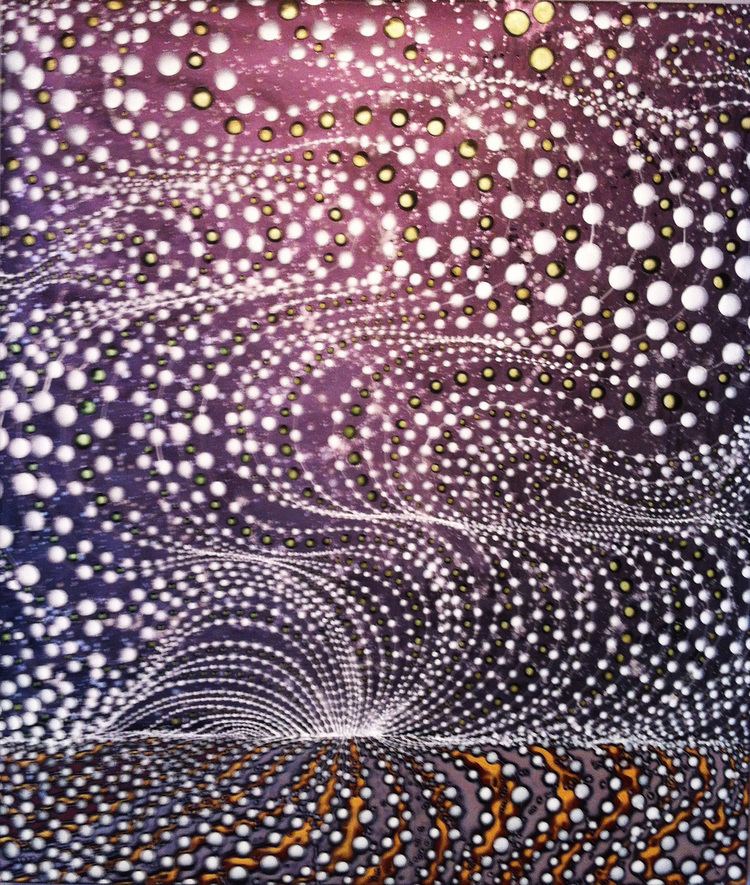 | ||
Full Name Barbara Takenaga Education | ||
Barbara takenaga at the gregory lind gallery
Barbara Takenaga (born 1949 in North Platte, Nebraska) is an abstract painter who is known for her swirling, dot-based paintings that recall cosmic and cellular imagery. She is currently represented by DC Moore Gallery in New York and by Gregory Lind Gallery in San Francisco.
Contents
- Barbara takenaga at the gregory lind gallery
- what follows interview series barbara takenaga
- Biography
- Work
- Critical reception
- Awards and honors
- Solo exhibitions
- Public Collections
- Exhibition Catalogs and Articles
- References

what follows interview series barbara takenaga
Biography
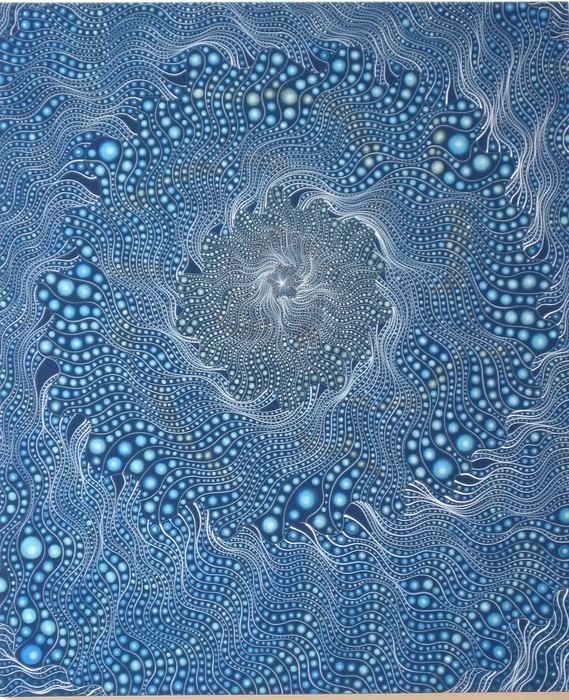
Takenaga attended the University of Colorado Boulder, earning a BFA in 1972 and a MFA in 1978. She has been the Mary A. & William Wirt Warren Professor of Art at Williams College since 1985. Takenaga also taught briefly at the University of Denver from 1982 to 1984.
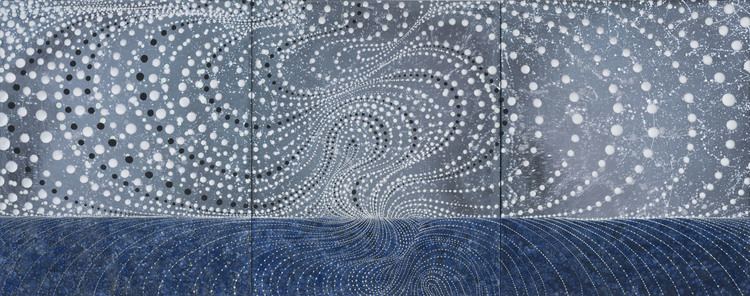
She currently lives and works both in Williamstown, MA and in New York, where her studio is located.
Work
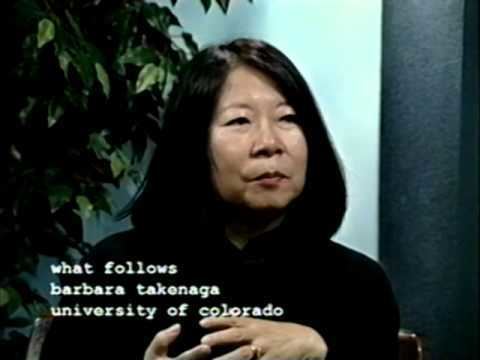
Although a printmaker early in her career, Takenaga is primarily known for her oil and acrylic paintings. She has been exhibiting her work since 1993.

Her paintings rely on the repetition of dots in saturated colors to form various patterns and create sweeping or spiraling movements. The center or horizon of these paintings often is lighter, creating a luminous effect. In the last several years, Takenaga's penchant for a neon-bright, even garish palette has changed following the death of her mother in 2002. The muted "twilight palette" of grays and blues reflects Takenaga's mourning. The artist has remarked that "the colors got icier and colder. I think these grey paintings have some sense of fading-- shiny, hazy, shifting."
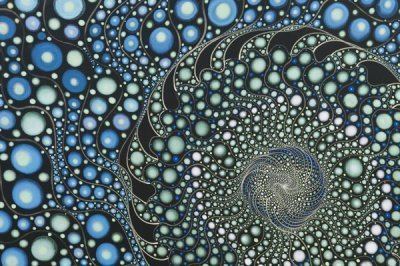
Due to her use of tessellated forms, Takenaga's work is noted for its challenging optical quality. A sense of infinity and boundlessness are associated with the dizzying patterns created in her paintings. Her series Night Paintings, for instance, are based on "recurring childhood dreams about the origins of the universe." Her upbringing in rural Nebraska is connected to this sense of "boundlessness." Art critic Nancy Princenthal suggests that "these paintings evoke the flat farmland of Takenaga's childhood home, in Nebraska [...] There is that sense of limitless, un marked expanses in Takenaga's recent paintings, of matter-of-fact infinitude."
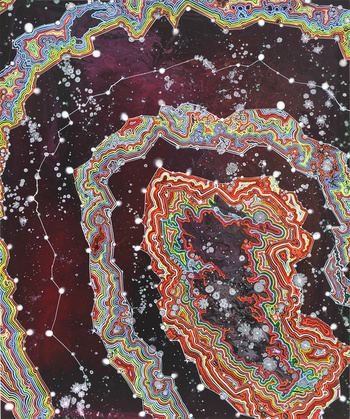
The laborious, repetitive process involved to make her paintings suggests the passing of time in her work. Susan Cross writes: "Takenaga has likened her approach to art-making to both soap opera narratives in which essentially nothing happens over long stretches of time and to the myth of Odysseus's wife Penelope, who unraveled her weaving each night for three years to put off her unwanted suitors. In a similar fashion, Takenaga's process both marks time and slows it down, allowing it to move forwards and backwards much like the sense of space in her paintings, which takes us spinning deep into the cosmos or right back to the work's surface, evoking both beginnings and endings."

Takenaga has been influenced by artists such as Charles Burchfield and Roger Brown (artist), among others.
Critical reception
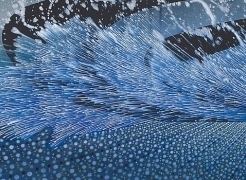
Critics often refer to Takenaga's style as "psychedelic."
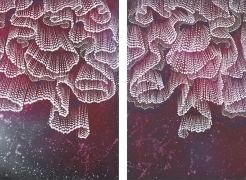
In reference to this Carol Diehl writes, "Takenaga’s work has been described as psychedelic, but that implies a loss of control, where these paintings are the result of acute attention. While they no doubt owe much to the precedents of Op art and Pattern and Decoration, Takenaga’s repetitive forms, like Ross Bleckner’s, inspire more mystical interpretation. If her idiosyncratic images can be said to resemble anything, it is van Gogh’s The Starry Night, with its swirls of celestial light updated to the computer age."
A reviewer for The New York Sun commented on the "prejudice" the viewer might have to overcome viewing Takenaga's paintings: "Once the eye adjusts to a sense of gaudy overload, and overcomes the prejudice of feeling you might have seen such imagery on the cover of a molecular chemistry textbook, it becomes clear that she is an image crafter of formidable power."
This opinion—overcoming the sense of "gaudy overload"—is also echoed by a review on artcritical.com. The reviewer writes that "While these transcendental apparitions might be misread as kitsch or imitations of 1960s psychedelia, the artist's skillful handling of her subject matter proves otherwise."
Carol Diehl also praised Takenaga's change to a more horizontal, landscape format. In 2012, she remarked that "The relatively recent addition of the horizon line is a major development for Takenaga [...] Few could have predicted that this normally balanced and stabilizing element would provide the disruption her work needed and a place from which it could expand. Previously her images were beautiful but congested, overshadowed by her painstaking and obsessive methodology. One would simply marvel that anyone could create such fine and intricate work freehand, especially with a material as mundane as acrylic paint. Further, the emphasis was on a kernel-like center that brought the eye from the outside in, whereas now the horizon line allows the nucleus to burst forth in burgeoning whorls that imply galaxies outside the picture plane."
In a 2007 article "The New Abstraction" in ARTNews, Barbara A. MacAdam cites Takenaga as well as Chris Martin (artist), Larry Poons, and others, as part of a general return to abstract painting.
Her compositions that use dots to form various waves and patterns have drawn favorable comparisons to the work of Yayoi Kusama. In a review of Takenaga's paintings in The New York Sun, art critic Franklin Einsprunch archly writes: "Think Yayoi Kusama, but with less obsessive-compulsive disorder and more feeling for paint."
Awards and honors
Solo exhibitions
2013
2012
2011
2010
2009
2008
2007
2006
2005
2004
2001
1997
1993
1992
1990
Public Collections
Exhibition Catalogs and Articles
2012
2011
2010
2009
2008
2007
2006
2005
2004
2003
2001
2000
1998
1997
